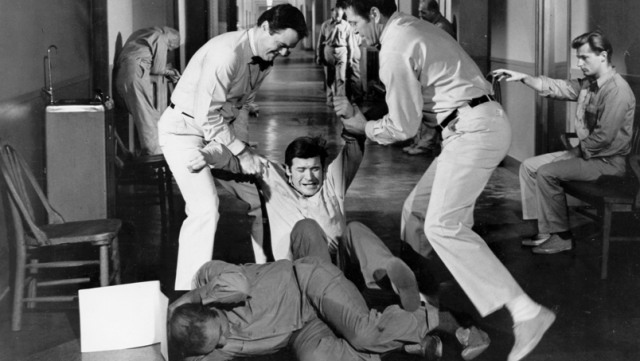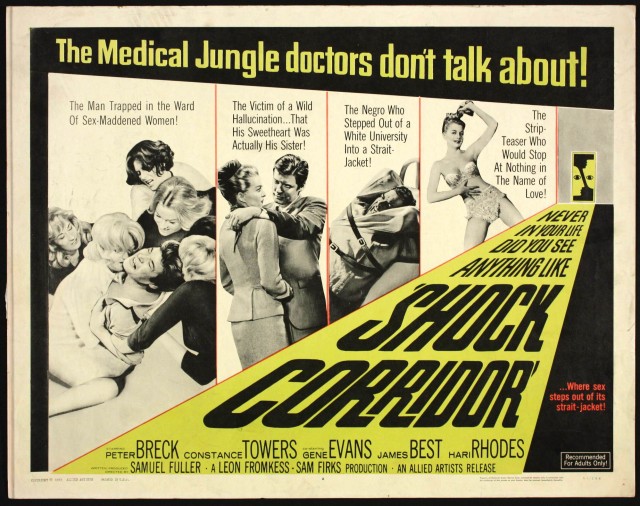
Reporter Johnny Barrett (Peter Breck) gets into more trouble than he bargained for in Samuel Fuller’s SHOCK CORRIDOR
ONE NITE ONLY: SHOCK CORRIDOR (Samuel Fuller, 1963)
Nitehawk Cinema
136 Metropolitan Ave. between Berry St. & Wythe Ave.
Wednesday, March 4, $15, 7:30
Series runs March 4-29
718-384-3980
www.nitehawkcinema.com
 On the surface, Samuel Fuller’s Shock Corridor is about a reporter’s unyielding determination to win a Pulitzer by playing a unique game of Clue: He gets his girlfriend and his publisher to help commit him to an insane asylum so he can get a big scoop by answering the question “Who killed Sloan with a knife in the kitchen?” But the tense psychological drama is actually about so much more, a treatise on the state of mid-twentieth-century America as well as the nature of storytelling itself. A former crime reporter, Fuller was inspired by Nellie Bly’s Ten Days in a Mad-House when making Shock Corridor, but his film is not so much an expose on the treatment of the mentally ill as an investigation into such prevalent societal ills as racism, war, communism, nuclear annihilation, and, er, nymphomania. Desperate for a big story, Johnny Barrett (Peter Breck) gets a lesson in how to act insane from Dr. Fong (Philip Ahn); they’ve decided that Johnny’s “ailment” will be incest, and he must pretend that he is in love with his sister, a role that will be taken by his girlfriend, Cathy (Constance Towers), a burlesque performer who is uncomfortable with the whole plan. The only other person who knows of the scheme is Johnny’s editor, old-time newspaperman Swanee (Bill Zuckert). Once locked inside the mental hospital, Johnny seeks out the three witnesses to Sloan’s slaying: Stuart (James Best), who thinks he’s a Confederate general still fighting the Civil War; Trent (Hari Rhodes), a black man who believes he’s a white supremacist; and Boden (Gene Evans), a scientist who has reverted to being a child because of the misuse of nuclear power. Keeping a close watch on everything are two attendants, the amiable Wilkes (Chuck Roberson) and the mean-spirited Lloyd (John Craig), along with Dr. Cristo (John Matthews), who has a thing for electric shock therapy. As Johnny keeps getting closer to the truth, however, the cost might be his own sanity.
On the surface, Samuel Fuller’s Shock Corridor is about a reporter’s unyielding determination to win a Pulitzer by playing a unique game of Clue: He gets his girlfriend and his publisher to help commit him to an insane asylum so he can get a big scoop by answering the question “Who killed Sloan with a knife in the kitchen?” But the tense psychological drama is actually about so much more, a treatise on the state of mid-twentieth-century America as well as the nature of storytelling itself. A former crime reporter, Fuller was inspired by Nellie Bly’s Ten Days in a Mad-House when making Shock Corridor, but his film is not so much an expose on the treatment of the mentally ill as an investigation into such prevalent societal ills as racism, war, communism, nuclear annihilation, and, er, nymphomania. Desperate for a big story, Johnny Barrett (Peter Breck) gets a lesson in how to act insane from Dr. Fong (Philip Ahn); they’ve decided that Johnny’s “ailment” will be incest, and he must pretend that he is in love with his sister, a role that will be taken by his girlfriend, Cathy (Constance Towers), a burlesque performer who is uncomfortable with the whole plan. The only other person who knows of the scheme is Johnny’s editor, old-time newspaperman Swanee (Bill Zuckert). Once locked inside the mental hospital, Johnny seeks out the three witnesses to Sloan’s slaying: Stuart (James Best), who thinks he’s a Confederate general still fighting the Civil War; Trent (Hari Rhodes), a black man who believes he’s a white supremacist; and Boden (Gene Evans), a scientist who has reverted to being a child because of the misuse of nuclear power. Keeping a close watch on everything are two attendants, the amiable Wilkes (Chuck Roberson) and the mean-spirited Lloyd (John Craig), along with Dr. Cristo (John Matthews), who has a thing for electric shock therapy. As Johnny keeps getting closer to the truth, however, the cost might be his own sanity.
The multiple levels of the characterizations in Shock Corridor are best represented by a patient played by Larry Tucker who thinks he is Pagliacci, a fictional character in the Leoncavallo opera who is portrayed by a tenor named Canio. Like Pagliacci, Fuller’s Shock Corridor is built around stories within stories (within stories) and actors playing characters pretending to be someone else. The film, which evokes The Snake Pit while presaging Miloš Forman’s One Flew Over the Cuckoo’s Nest, including an important use of gum, is shot by Stanley Cortez in noirish black-and-white, but Fuller adds several full-color dream sequences taken from footage he photographed for other projects, further blurring the lines between fiction and reality within the context of this original drama. As with so many of Fuller’s works, the film is highly influential, although more beloved and known by fellow filmmakers than mainstream audiences. And it does no favors for the treatment of the mentally ill, either on the doctor or patient side of things. But it’s all worth it for the amazing rain scene that will blow your mind. Shock Corridor is screening in a 35mm print on March 4 at 7:30, kicking off Nitehawk Cinema’s March Brunch “Committed” series, with a special guest to be announced. Yes, 7:30 pm is an odd time to have brunch, but maybe the programmer had temporarily lost his marbles. The series continues on March weekends — at the more normal brunch times of either 11:30 or 12 noon — with Alfred Hitchcock’s Spellbound, One Flew Over the Cuckoo’s Nest, Joseph L. Mankiewicz’s Suddenly, Last Summer, Robert Wiene’s The Cabinet of Dr. Caligari, and James Mangold’s Girl, Interrupted.
